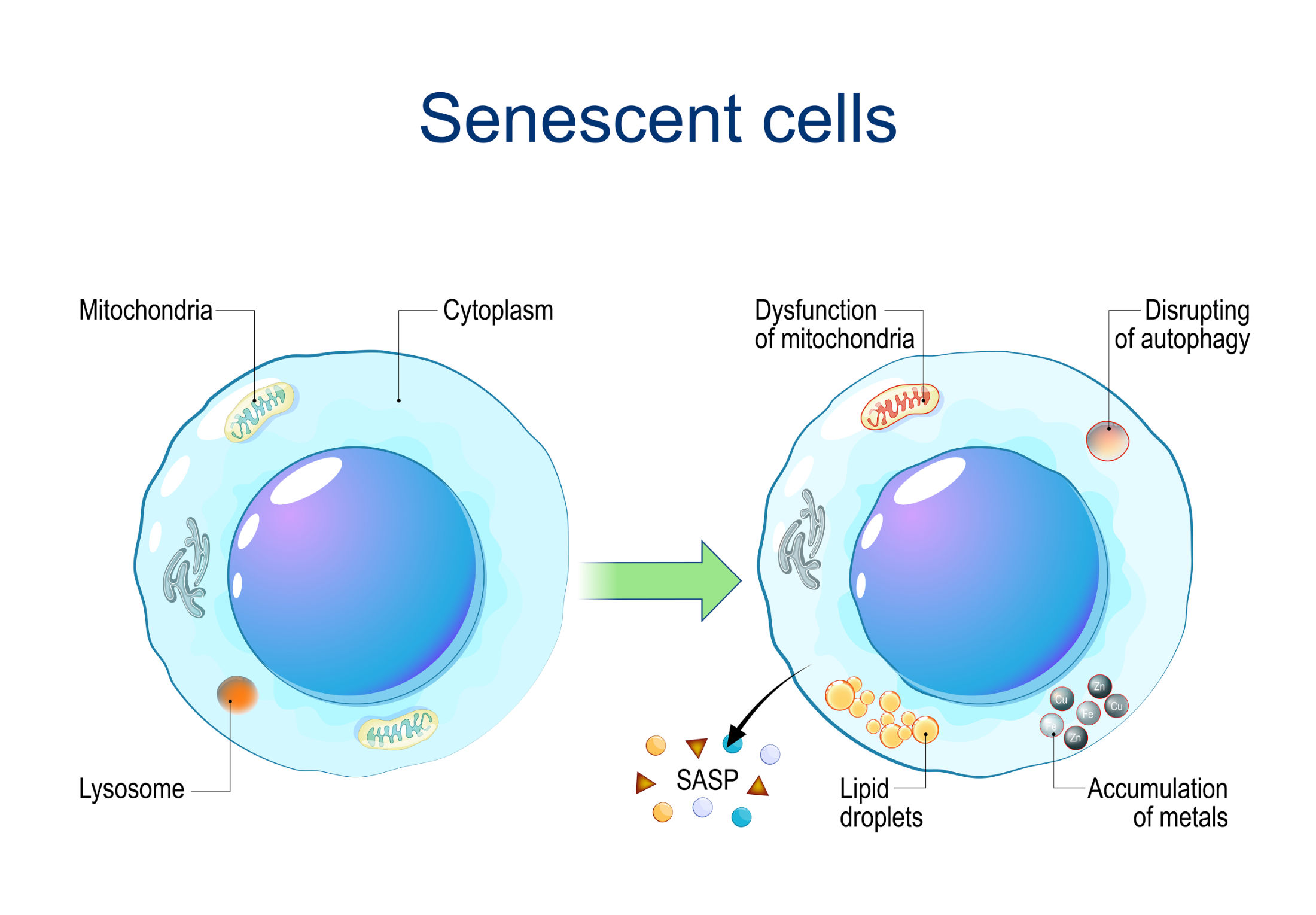Table of Contents:
- What exactly does cellular senescence mean?
- How do you recognize senescent cells?
- The Janus-faced nature of senescence
- Revolutionary therapeutic approaches against zombie cells
- Senomorphics – the gentler alternative
- From the laboratory to the clinic – where do we stand today?
- Your personal anti-senescence strategy
- The future of healthy ageing

Zombies don’t just exist in the movies. They are also a powerful driver of the ageing process. To be more precise, it is so-called zombie cells that cause us to age. This is because they constantly send out messenger substances that affect healthy cells and accelerate the ageing process. This phenomenon is called cellular senescence – one of the twelve hallmarks of ageing, the fundamental biological processes that scientists have identified as the main drivers of ageing.
What was meant to be a fascinating protective mechanism turns against us as we get older. Research is doing everything it can to reverse this process and help us to live longer, healthier lives.
What exactly does cellular senescence mean?
Cellular senescence is a permanent growth arrest of cells that occurs in response to various stress factors. If your cells have DNA damage, oxidative stress or shortened telomeres (the protective caps at the ends of chromosomes), they can enter this state. Instead of dividing or dying, they remain in a kind of “zombie state” – metabolically active but no longer able to perform their normal functions.
This phenomenon was discovered back in 1961 by Leonard Hayflick . He observed that human cells can only divide around 40 to 60 times before they enter this senescent state. Today we know: What began as a protective mechanism against cancer becomes a problem in old age when these cells accumulate in the body. The accumulation of senescent cells has therefore been classified as an independent hallmark of ageing – a hallmark that is closely linked to other ageing processes such as chronic inflammation and stem cell depletion.

The toxic influence of senescent cells
What makes senescent cells particularly dangerous is their so-called senescence-associated secretory phenotype (SASP). These cells are by no means inactive – on the contrary, they produce a veritable cocktail of
inflammation-promoting messenger substances
growth factors and tissue-damaging enzymes. This mix not only damages the surrounding tissue, but can also “infect” healthy neighboring cells and drive them into a senescent state. The result is a vicious circle that promotes inflammatory processes and contributes significantly to age-related diseases such as arthritis, diabetes, cardiovascular disease and even Alzheimer’s disease.
Thus, cellular senescence not only reinforces itself, but also drives other hallmarks of aging such as inflammaging and mitochondrial dysfunction.
How do you recognize senescent cells?
In the laboratory, senescent cells can be identified by characteristic biomarkers. The best known is senescence-associated β-galactosidase (SA-β-Gal), an enzyme that is particularly active in senescent cells. Other important markers are the increased expression of the cell cycle inhibitors p16INK4a and p21.
These proteins act as molecular brakes and prevent the cell from dividing further. Interestingly, p16INK4a expression in human tissues increases with age and is therefore considered a reliable indicator of biological age.
Thanks to modern detection methods, scientists can now quantify the accumulation of senescent cells in various tissues and thus better understand the connection with age-related diseases.
The Janus-faced nature of senescence
Cellular senescence is a biological paradox: at a young age, it protects us from cancer by preventing damaged cells from dividing uncontrollably. It also plays an important role in wound healing and during embryonic development. It only becomes a problem as we get older, when our immune system no longer works efficiently enough to eliminate these cells.
This double-edged nature makes the development of therapies particularly challenging. The aim is not to completely eliminate senescence, but rather to achieve a healthy balance – which is precisely where modern anti-ageing strategies come in.
Revolutionary therapeutic approaches against zombie cells
In recent years, research has produced two promising approaches to combat the negative effects of senescent cells: senolytics and senomorphics.
Senolytics are active substances that selectively cause senescent cells to die. The best known of these include dasatinib (a cancer drug), quercetin (a natural flavonoid) and the BCL-2 inhibitor navitoclax. These substances have already shown impressive results in animal experiments: Mice lived longer, stayed healthier and showed improvements in age-related diseases such as arthritis and pulmonary fibrosis.
Senomorphics – the gentler alternative
Senomorphics, on the other hand, do not kill senescent cells but suppress their harmful SASP. This class of drugs includes mTOR inhibitors such as rapamycin, JAK inhibitors and various natural substances. They intervene in the signaling pathways that lead to the production of pro-inflammatory factors and can thus mitigate the negative effects of senescent cells.
The advantage of this approach is that senomorphics preserve potentially beneficial aspects of senescence, such as tumor suppression, while reducing the harmful effects. For some applications, a combination of senolytics and senomorphics could be the optimal strategy.
From the laboratory to the clinic – where do we stand today?
More than 30 clinical trials with senolytic and senomorphic active ingredients are currently underway worldwide. These are being tested for a wide range of indications – from Alzheimer’s and chronic kidney disease to osteoarthritis and age-related frailty. Initial results are optimistic, even if there is still a long way to go before they are approved as anti-ageing therapeutics.
The combination of senotherapeutics with regenerative approaches appears particularly promising: First the harmful senescent cells are removed, then the regeneration of the tissue is promoted – a holistic approach to healthy ageing.
Your personal anti-senescence strategy
While medical research continues on medications, you can take steps today to reduce the accumulation of senescent cells. Regular physical activity, an antioxidant-rich diet with plenty of fruit and vegetables and sufficient sleep can slow down cellular senescence.
Intermittent fasting and caloric restriction have also been shown in studies to reduce the accumulation of senescent cells. Food supplements such as quercetin and fisetin, which are found in apples, onions and strawberries, are also being discussed as natural senolytics – even if their effectiveness in the current dosage as food supplements has not yet been conclusively proven.
The future of healthy ageing
Cellular senescence is not only a fascinating biological phenomenon, but also a key to understanding and influencing the ageing process. As research progresses, ever more precise and effective therapies are being developed – from targeted delivery systems and nanoparticles to AI-supported drug development.
What still sounds like science fiction today could be reality tomorrow: a life in which we not only live longer, but above all healthier, with fewer age-related diseases and more vital years. Combating cellular senescence could be one of the most important levers here.
Sources:
pmc.ncbi.nlm.nih.gov – Hallmarks of senescence and aging
genomebiology.biomedcentral.com – A multidimensional systems biology analysis of cellular senescence in aging and disease
jci.org – Cellular senescence: a key therapeutic target in aging and diseases
mdpi.com – Targeting Senescence: A Review of Senolytics and Senomorphics in Anti-Aging Interventions
nature.com – Cellular senescence and senolytics: the path to the clinic
🩺 Medizinisch geprüft am 11.10.2025
This article has been professionally reviewed by Dr. Verena Immer. She is a doctor of integrative and anti-ageing medicine with a holistic approach that combines conventional medical knowledge with complementary methods. She has successfully applied the concept of individualized medicine in her own practice near Munich and currently offers personalized medicine – with a focus on longevity – in Switzerland.
Image source: istockphoto.com
- Mother and daughter. Generation. Young and older women | credits @ JNemchinova
- Senescent cells. Cellular senescence | credits @ ttsz
Disclaimer
This blog is for general informational purposes only and does not constitute the practice of medicine, nursing or other professional health care services, including the giving of medical advice, and no doctor-patient relationship is established. Use of any information contained in this blog or materials linked to this blog is at the user’s own risk. The content of this blog is not intended as a substitute for professional medical advice, diagnosis or treatment. Users should not ignore or delay medical advice for any medical conditions they may have and should seek the help of their healthcare professional for such conditions.









